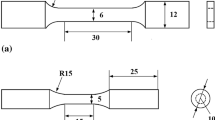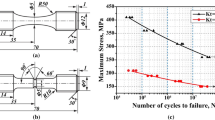Abstract
Micro porosity in aluminum alloys may contribute to fatigue life degradation, which can largely limit the application of alloys. Therefore, the fatigue life of a commercial 7050-T7451 thick plate and an experimental plate with different porosities was compared in this study. The X-ray computed tomography (XCT) was utilized to characterize the size, number density and spatial distribution of porosity inside various samples, and the fracture surface of fatigued specimens was compared by using scanning electron microscope (SEM). The results showed that the fatigue cracks prefer to initiate from constituent particles in the commercial alloy. Whereas the micro porosity is the predominant site for crack nucleation and subsequent failure in the experimental one. The presence of micro porosity in experimental 7050-T7451 thick plate may reduce the fatigue life by an order of magnitude or more compared with the defect-free alloy. The pores close to sample surface are the main fatigue crack initiation site, among which larger and deeper pore leads to a shorter fatigue life. The crack initiation is also affected by the pore geometry and direction. Besides, the overall porosity inside the bulk can affect the crack propagation during fatigue tests.
摘要
铝合金材料中的显微疏松会导致其疲劳性能的降低, 很大程度上限制了合金的应用. 本研究针对7050-T7451铝合金厚板进行了分析, 对比了不同孔隙率板材之间疲劳性能差异. 本研究实验运用了X射线计算机断层成像法(XCT)对材料孔隙率进行了分析, 包括孔洞尺寸、 数密度以及其尺寸分布, 同时运用扫描电镜(SEM)对疲劳断口特征进行了分析. 结果表明, 对于孔洞较少且尺寸小的样品而言, 疲劳裂纹更倾向于从第二相粒子产生, 而对于孔洞较大且密度较高的样品而言, 裂纹更容易起始于样品表面处的大尺寸孔洞. 相比于几乎没有孔洞的样品而言, 含有高孔隙率的样品疲劳寿命缩短将近一个数量级, 样品疲劳寿命与孔洞大小和深度呈反比关系, 且不同形状与朝向的孔洞对疲劳寿命也会造成影响. 同时, 结果分析可知, 样品整体的孔隙率对疲劳长裂纹扩展也会造成一定影响.
Similar content being viewed by others
References
WILLIAMS J C, STARKE E A. Progress in structural materials for aerospace systems [J]. Acta Materialia, 2003, 51(19): 5775–5799. DOI: https://doi.org/10.1016/j.actamat.2003.08.023.
WANG Jin-san, KANG Yong-wang, LI Chang-rong. Phase diagram and phase equilibrium studies on ultra high temperature alloys of Nb−Si−Ti [J]. Materials Science Forum, 2016, 849: 618–625. DOI: https://doi.org/10.4028/www.scientific.net/msf.849.618.
WANG J S, XIAO X. Thermodynamic, kinetic and strength calculation of high zinc containing Al−Zn−Mg−Cu alloys [J]. Crystals, 2022, 12: 181–191. DOI: https://doi.org/10.3390/cryst12020181.
WANG Jin-san. Kinetic and strength calculation of age-hardening phases in heat-resistant aluminum alloys with silver [J]. Materials Science Forum, 2020, 993: 1051–1056. DOI: https://doi.org/10.4028/www.scientific.net/MSF.993.1051.
ROBSON J D. Microstructural evolution in aluminium alloy 7050 during processing [J]. Materials Science and Engineering A, 2004, 382(1, 2): 112–121. DOI: https://doi.org/10.1016/j.msea.2004.05.006.
SCHUBBE J J. Fatigue crack propagation in 7050-T7451 plate alloy [J]. Engineering Fracture Mechanics, 2009, 76(8): 1037–1048. DOI: https://doi.org/10.1016/j.engfracmech.2009.01.006.
LI G, TANG J, ZHOU W, et al. Fatigue life prediction of workpiece with 3D rough surface topography based on surface reconstruction technology [J]. Journal of Central south university, 2018, 25: 2069–2075. DOI: https://doi.org/10.1007/s11771-018-3896-3.
JIAO Y, ZHANG Y, MA S, et al. Effects of microstructural heterogeneity on fatigue properties of cast aluminum alloys [J]. Journal of Central South University, 2020, 27: 674–697. DOI: https://doi.org/10.1007/s11771-020-4323-0.
MAYER H, PAPAKYRIACOU M, ZETTL B, et al. Influence of porosity on the fatigue limit of die cast magnesium and aluminium alloys [J]. International Journal of Fatigue, 2003, 25(3): 245–256. DOI: https://doi.org/10.1016/S0142-1123(02)00054-3.
NADOT Y, MENDEZ J, RANGANATHAN N. Influence of casting defects on the fatigue limit of nodular cast iron [J]. International Journal of Fatigue, 2004, 26(3): 311–319. DOI: https://doi.org/10.1016/S0142-1123(03)00141-5.
WANG Q G, APELIAN D, LADOS D A. Fatigue behavior of A356-T6 aluminum cast alloys. Part I. Effect of casting defects [J]. Journal of Light Metals, 2001, 1(1): 73–84. DOI: https://doi.org/10.1016/S1471-5317(00)00008-0.
WANG Q G, APELIAN D, LADOS D A. Fatigue behavior of A356/357 aluminum cast alloys. Part II — Effect of microstructural constituents [J]. Journal of Light Metals, 2001, 1(1): 85–97. DOI: https://doi.org/10.1016/S1471-5317(00)00009-2.
EL KHOUKHI D, MOREL F, SAINTIER N, et al. Experimental investigation of the size effect in high cycle fatigue: Role of the defect population in cast aluminium alloys [J]. International Journal of Fatigue, 2019, 129: 105222. DOI: https://doi.org/10.1016/j.ijfatigue.2019.105222.
AMMAR H R, SAMUEL A M, SAMUEL F H. Effect of casting imperfections on the fatigue life of 319-F and A356-T6 Al−Si casting alloys [J]. Materials Science and Engineering A, 2008, 473(1–2): 65–75. DOI: https://doi.org/10.1016/j.msea.2007.03.112.
XU Zhi-qiang, WEN Wei, ZHAI Tong-guang. Effects of pore position in depth on stress/strain concentration and fatigue crack initiation [J]. Metallurgical and Materials Transactions A, 2012, 43(8): 2763–2770. DOI: https://doi.org/10.1007/s11661-011-0947-x.
HIDALGO R, ESNAOLA J A, LLAVORI I, et al. Fatigue life estimation of cast aluminium alloys considering the effect of porosity on initiation and propagation phases [J]. International Journal of Fatigue, 2019, 125: 468–478. DOI: https://doi.org/10.1016/j.ijfatigue.2019.04.006.
MURAKAMI Y. Material defects as the basis of fatigue design [J]. International Journal of Fatigue, 2012, 41: 2–10. DOI: https://doi.org/10.1016/j.ijfatigue.2011.12.001.
KUWAZURU O, MURATA Y, HANGAI Y, et al. X-ray CT inspection for porosities and its effect on fatigue of die cast aluminium alloy [J]. Journal of Solid Mechanics and Materials Engineering, 2008, 2(9): 1220–1231. DOI: https://doi.org/10.1299/jmmp.2.1220.
BUFFIÈRE J Y, SAVELLI S, JOUNEAU P H, et al. Experimental study of porosity and its relation to fatigue mechanisms of model Al−Si7−Mg0.3 cast Al alloys [J]. Materials Science and Engineering A, 2001, 316(1–2): 115–126. DOI: https://doi.org/10.1016/S0921-5093(01)01225-4.
LE V D, SAINTIER N, MOREL F, et al. Investigation of the effect of porosity on the high cycle fatigue behaviour of cast Al−Si alloy by X-ray micro-tomography [J]. International Journal of Fatigue, 2018, 106: 24–37. DOI: https://doi.org/10.1016/j.ijfatigue.2017.09.012.
ZHANG B, CHEN W, POIRIER D R. Effect of solidification cooling rate on the fatigue life of A356.2-T6 cast aluminium alloy [J]. Fatigue & Fracture of Engineering Materials and Structures, 2000, 23(5): 417–423. DOI: https://doi.org/10.1046/j.1460-2695.2000.00299.x.
MU P, NADOT Y, NADOT-MARTIN C, et al. Influence of casting defects on the fatigue behavior of cast aluminum AS7G06-T6 [J]. International Journal of Fatigue, 2014, 63: 97–109. DOI: https://doi.org/10.1016/j.ijfatigue.2014.01.011.
CHAN K S. Roles of microstructure in fatigue crack initiation [J]. International Journal of Fatigue, 2010, 32(9): 1428–1447. DOI: https://doi.org/10.1016/j.ijfatigue.2009.10.005.
SERRANO-MUNOZ I, BUFFIERE J Y, MOKSO R, et al. Location, location & size: Defects close to surfaces dominate fatigue crack initiation [J]. Scientific Reports, 2017, 7: 45239. DOI: https://doi.org/10.1038/srep45239.
Author information
Authors and Affiliations
Contributions
The overall research goal was developed by XIAO Xiang. XIAO Xiang and ZHANG Qi conducted the literature review, analyzed the results and wrote the first draft. JIANG Hui-xue conducted the XCT characterization. CAO Ling-fei edited the draft of manuscript. All authors replied to reviewers’ comments and revised the manuscript. The whole project was supervised by LIU Cheng.
Corresponding authors
Ethics declarations
XIAO Xiang, ZHANG Qi, JIANG Hui-xue, LIU Cheng and CAO Ling-fei declare that they have no conflict of interest.
Additional information
Foundation item: Project(2019KJ2X08-4) supported by Chinalco Technology Development Project Fund, China
Rights and permissions
About this article
Cite this article
Xiao, X., Zhang, Q., Jiang, Hx. et al. Micro porosity and its effect on fatigue performance of 7050 aluminum thick plates. J. Cent. South Univ. 29, 912–923 (2022). https://doi.org/10.1007/s11771-022-4961-5
Received:
Accepted:
Published:
Issue Date:
DOI: https://doi.org/10.1007/s11771-022-4961-5




